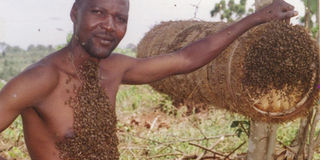Bees choke as pollutants fill the air

UNEP has urged farmers to grow more flowering plants that attract bees. FILE PHOTO
Bees are under threat after a report indicated that air pollution and harmful pesticides could be behind an emerging decline in bees colonies globally, a report by the United Nations Environment Programme (UNEP) has revealed.
The report, titled Global Bee Colony Disorders and other Threats to Insect Pollinators, also cites spread of pests, decline in flowering plants, as factors threatening the honey-making insects.
The report states that humans are rapidly changing the conditions and ground rules that support life on Earth and depending hugely on the ecosystem even for food production, activities affecting survival of bees and other insects.
“Although daytime insects depend primarily on vision to find flowers, pollutants affect the chemicals that flowers produce to attract insects, which destroys vital scent trails. Scents that could travel over 800m in the 1800s now reach less than some 200m from the plant, which complicates pollinators’ ability to locate food sources,” the report, published by UNEP on March 10, reveal.
The report indicates that the threat to bees are early warning indicators of wider impacts on animal and plant life and that measures to boost pollinators could not only improve food security but the fate of many other economically and environmentally-important plants and animals.
The authors of the report recommended that farmers and landowners should be offered incentives to restore pollinator-friendly habitats, and key flowering plants in crop-producing fields.
The UN Food and Agriculture Organisation estimates that out of some 100 crop species which provide 90 per cent of food worldwide, 71 of these are bee-pollinated.
About 20,000 flowering plant species, upon which many bee species depend on for food, could be lost over the coming decades unless conservation efforts are stepped up.
Industrial pollutants
A 2009 World Bank survey found that vehicles contributed the highest volume of air pollutants in Uganda, accounting for 69 per cent of sulphur dioxide emissions, 59 per cent of nitrogen dioxide and 69 per cent of benzene.
Domestically-burned wood and charcoal ranked second as a source of pollution.
Industrial sources, which mostly emitted sulphur oxides, ranked third. In Kampala, dust was noted to be second biggest contributor to particulate matter with 47 per cent after domestic sources.




